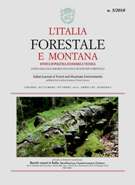Special section
STRUCTURAL PATTERNS, GROWTH PROCESSES, CARBON STOCKS IN AN ITALIAN NETWORK OF OLD-GROWTH BEECH FORESTS
Published 2013-05-16
Keywords
- old-growth forests,
- tree-ring,
- dendroecology,
- disturbance regime,
- carbon stocks
- stable isotopes ...More
Copyright (c) 2013 Italian Journal of Forest and Mountain Environments

This work is licensed under a Creative Commons Attribution-NonCommercial 4.0 International License.
Abstract
In the framework of the Project of National Interest (PRIN) “Climate change and forests - Dendroecological and ecophysiological responses, productivity and carbon balanceon the Italian network of old-growth beech forests”, 9 old beech (Fagus sylvatica L.) forests were sampled in the eastern Alps and in the central Apennines to assess: i) the degree of
‘old-growthness’ on a structural and dendroecological basis; ii) the carbon (C) stocks in the different ecosystem compartments; iii) some ecophysiological traits using stable isotopes.
Live and dead tree structure, soil features and C stocks were examined in some among the oldest and less disturbed beech forests in Italy. Furthermore, leaves, litter and wood cores were sampled for concurrent dendroecological, nutrient and stable isotope analysis, to study age structure, disturbance history and medium- and long-term response to climate and ecophysiological traits.
In all sampled stands, values of basal area, volume and large trees density reached or exceeded control values reported for European and North American old-growth forests, while total amount of deadwood was generally low, except in two sites. Diameter distribution showed a remarkable differentiation from bimodal to ‘rotated-sigmoid’ curve.
In accordance with structural analyses, disturbance chronologies revealed the importance of frequent low-to-moderate events in generating a fine-scale structure, confirming previousresults on beech forests. Different degrees of ‘old-growthness’ were identified for Alpine and
Apennine beech stands through the ‘structural-based approach’, which proved to be a valid tool for old-growth forests detection. Preliminary results on carbon stocks on a subset of
sites indicate that these old-growth forests are relevant carbon reservoirs, with 192-268 MgC ha-1 of total biomass (67-73% aboveground; 27-33% belowground, 4 stands) and 7-21
MgC ha-1 of deadwood. In these stands, also forest floor (excluding deadwood) and soils are stores of relevant amount of carbon (5-9 MgC ha-1 litter layer, 4 stands; 168-420 MgC ha-1 mineral soil, 3 stands). Finally, carbon isotope discrimination (Δ) analysis, a proxy of wateruse efficiency, was applied on tree-ring cores from a subset of sites. The perspectives of this technique for a retrospective ecophysiological interpretation of climate-change impact on
old-growth forests were described.
Preliminary results obtained within this PRIN project indicate that the reported ecological indicators can be used to produce a description of forest structures and processes driving stand dynamics (‘structural-based approach’). Furthermore, the use of multiple sampling and research techniques and the integration of research groups with complementary expertise can foster deeper understanding of the ecology and dynamics of old-growth forests.

